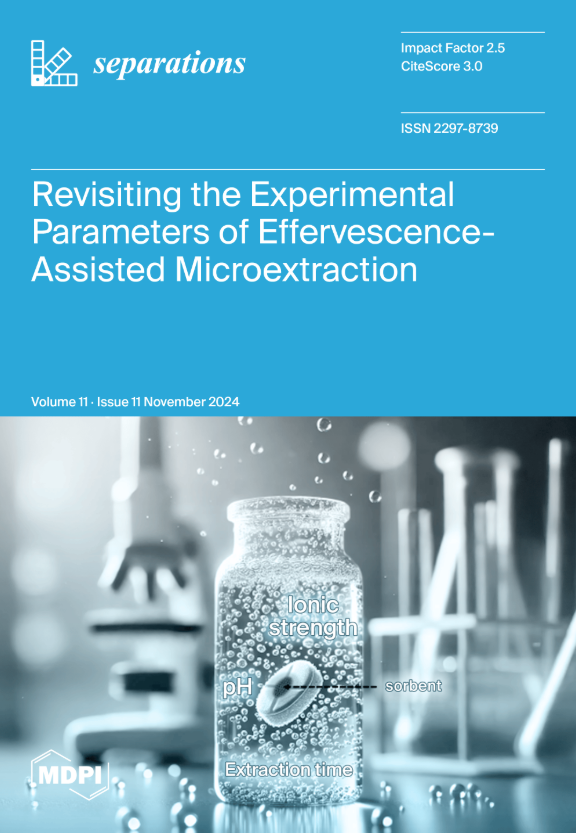采用响应面方法优化和验证同时测定 SNEDDs 配方中胸腺醌和格列本脲的灵敏 UPLC-PDA 方法
IF 2.7
4区 工程技术
Q3 CHEMISTRY, ANALYTICAL
引用次数: 0
摘要
由于存在由不同原料药组成的不同制剂,因此开发能够同时测定两种或两种以上药物的分析程序至关重要。本研究旨在采用响应面方法优化和验证一种简单、准确、灵敏的超高效液相色谱分析方法,用于同时测定胸腺醌(TQ)和格列本脲(GB),并将该方法应用于药物制剂中。采用 32 全实验设计研究了独立参数(乙腈-ACN 浓度,A;色谱柱温度,B)对药物分析属性(即保留时间、峰面积、峰不对称以及 TQ 和 GB 峰之间的分辨率)的影响。结果显示,独立参数对 TQ 和 GB 峰的保留时间有非常显著的拮抗作用(p < 0.05),而对 GB 峰的对称性则无影响(p 值 = 0.001)。此外,两个独立因素(A 和 B)对 TQ 和 GB 峰之间的分辨率也有拮抗作用(p < 0.05)。统计软件显示,46.86%的乙腈(A)和 38.80 °C 的色谱柱温度(B)可获得最佳分析响应。优化后的绿色方法在选择性、精密度、准确度、稳健性、灵敏度和特异性方面均可接受。结果表明,自纳米乳化给药(SNEDD)制剂中GB和TQ的含量分别为1.54 ± 0.023 mg/gm和3.62 ± 0.031 mg/gm。总之,所开发的检测方法在同时分析散剂和自纳米乳化给药系统(SNEDDs)制剂中的 TQ 和 GB 方面是高效和有效的。本文章由计算机程序翻译,如有差异,请以英文原文为准。
Optimization and Validation of Sensitive UPLC-PDA Method for Simultaneous Determination of Thymoquinone and Glibenclamide in SNEDDs Formulations Using Response Surface Methodology
The development of analytical procedures capable of simultaneous determination of two or more drugs is in crucial demand due to the availability of different formulations that are composed of different APIs. The presented study aimed to optimize and validate a simple, accurate, and sensitive UPLC analytical method for the simultaneous determination of thymoquinone (TQ) and Glibenclamide (GB) using response surface methodology, and apply this method in pharmaceutical formulations. A 32 full design of experiment was utilized to study the impacts of the independent parameters (acetonitrile ACN concentration, A; and column temperature, B) on the drugs’ analytical attributes (viz, retention time, peak area, and peak asymmetry, in addition to the resolution between TQ and GB peaks). The results revealed that the independent parameters exhibited highly significant (p < 0.05) antagonistic effects on retention times for TQ and GB peaks, in addition to the agnostic effect on GB peak symmetry (p-value = 0.001). Moreover, antagonistic impacts (p < 0.05) on the resolution between TQ and GB peaks were found for both independent factors (A and B). The statistical software suggested 46.86% of ACN (A) and 38.80 °C for column temperature (B) for optimum analytical responses. The optimized green method was discovered to be acceptable in terms of selectivity, precision, accuracy, robustness, sensitivity, and specificity. Moreover, the optimized simultaneous method was successfully able to determine the contents of TQ and GB in self-nanoemulsifying drug delivery (SNEDD) formulation, in which the results showed that GB and TQ content within the prepared formulations were 1.54 ± 0.023 and 3.62 ± 0.031 mg/gm, respectively. In conclusion, the developed assay was efficient and valid in analyzing TQ and GB simultaneously in bulk and self-nanoemulsifying drug delivery system (SNEDDs) formulations.
求助全文
通过发布文献求助,成功后即可免费获取论文全文。
去求助
来源期刊

Separations
Chemistry-Analytical Chemistry
CiteScore
3.00
自引率
15.40%
发文量
342
审稿时长
12 weeks
期刊介绍:
Separations (formerly Chromatography, ISSN 2227-9075, CODEN: CHROBV) provides an advanced forum for separation and purification science and technology in all areas of chemical, biological and physical science. It publishes reviews, regular research papers and communications. Our aim is to encourage scientists to publish their experimental and theoretical results in as much detail as possible. There is no restriction on the length of the papers. The full experimental details must be provided so that the results can be reproduced. There are, in addition, unique features of this journal:
Manuscripts regarding research proposals and research ideas will be particularly welcomed.
Electronic files and software regarding the full details of the calculation and experimental procedure, if unable to be published in a normal way, can be deposited as supplementary material.
Manuscripts concerning summaries and surveys on research cooperation and projects (that are funded by national governments) to give information for a broad field of users.
The scope of the journal includes but is not limited to:
Theory and methodology (theory of separation methods, sample preparation, instrumental and column developments, new separation methodologies, etc.)
Equipment and techniques, novel hyphenated analytical solutions (significantly extended by their combination with spectroscopic methods and in particular, mass spectrometry)
Novel analysis approaches and applications to solve analytical challenges which utilize chromatographic separations as a key step in the overall solution
Computational modelling of separations for the purpose of fundamental understanding and/or chromatographic optimization
 求助内容:
求助内容: 应助结果提醒方式:
应助结果提醒方式:


